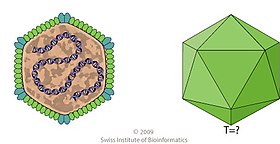Rhizidiovirus: Difference between revisions
m v2.04b - Bot T5 CW#2 - Fix errors for CW project (Tag with incorrect syntax) |
Velayinosu (talk | contribs) type species rank abolished |
||
| Line 5: | Line 5: | ||
| image_caption = ''Rhizidiomyces virus'' |
| image_caption = ''Rhizidiomyces virus'' |
||
| taxon = Rhizidiovirus |
| taxon = Rhizidiovirus |
||
| type_species = ''Rhizidiomyces virus'' |
|||
}} |
}} |
||
'''''Rhizidiovirus''''' is a genus of [[viruses]]. [[Stramenopile]]s<ref>Dawe VH, Kuhn CW (1983) Isolation and characterization of a double-stranded DNA mycovirus infecting the aquatic fungus, ''Rhizidiomyces''. Virology 130(1):21–28</ref> ([[fungi]] and [[hyphochytridiomycota]]) serve as natural hosts. There is only one species in this genus: |
'''''Rhizidiovirus''''' is a genus of [[viruses]]. [[Stramenopile]]s<ref>Dawe VH, Kuhn CW (1983) Isolation and characterization of a double-stranded DNA mycovirus infecting the aquatic fungus, ''Rhizidiomyces''. Virology 130(1):21–28</ref> ([[fungi]] and [[hyphochytridiomycota]]) serve as natural hosts. There is only one species in this genus: '''''Rhizidiomyces virus'''''.<ref name=ViralZone>{{cite web|title=Viral Zone|url=http://viralzone.expasy.org/all_by_species/640.html|publisher=ExPASy|access-date=15 June 2015}}</ref><ref name=ICTV>Heterocapsa circularisquama DNA virus 01</ref> |
||
==Taxonomy== |
|||
<big>'''Group: dsDNA'''</big> |
|||
{{Collapsible list|title= <big>Order: Unassigned</big> |
|||
|1={{Collapsible list| framestyle=border:none; padding:1.0em;|title=Family: Unassigned |
|||
|1={{hidden begin|title=<small>Genus: Rhizidiovirus</small>}} |
|||
*<small>'''''[[Rhizidiomyces virus]]'''''</small> |
|||
{{hidden end}} |
|||
}} |
|||
}}<ref name=ICTV /> |
|||
==Structure== |
==Structure== |
||
| Line 30: | Line 19: | ||
! Genus !! Structure || Symmetry !! Capsid !! Genomic arrangement !! Genomic segmentation |
! Genus !! Structure || Symmetry !! Capsid !! Genomic arrangement !! Genomic segmentation |
||
|- |
|- |
||
|Rhizidiovirus||Icosahedral||||Non-enveloped||Linear||Monopartite |
|''Rhizidiovirus''||Icosahedral||||Non-enveloped||Linear||Monopartite |
||
|} |
|} |
||
| Line 42: | Line 31: | ||
! Genus !! Host details !! Tissue tropism !! Entry details !! Release details !! Replication site !! Assembly site !! Transmission |
! Genus !! Host details !! Tissue tropism !! Entry details !! Release details !! Replication site !! Assembly site !! Transmission |
||
|- |
|- |
||
|Rhizidiovirus||Fungi Hyphochytridiomycota||None||Unknown||Lysis||Nucleus||Nucleus||Passive Diffusion, Vertical |
|''Rhizidiovirus''||Fungi Hyphochytridiomycota||None||Unknown||Lysis||Nucleus||Nucleus||Passive Diffusion, Vertical |
||
|} |
|} |
||
Revision as of 02:18, 25 May 2021
| Rhizidiovirus | |
|---|---|

| |
| Rhizidiomyces virus | |
| Virus classification | |
| (unranked): | Virus |
| Genus: | Rhizidiovirus |
Rhizidiovirus is a genus of viruses. Stramenopiles[1] (fungi and hyphochytridiomycota) serve as natural hosts. There is only one species in this genus: Rhizidiomyces virus.[2][3]
Structure

Viruses in Rhizidiovirus are non-enveloped, with icosahedral, round, and isometric geometries. The diameter is around 60 nm.[2]
The genome is non segmented, linear double stranded DNA and ~25.5 kilobases in length. It has a guanine + cytosine content of 42%. It encodes at least 14 protein with molecular weights between 84.5 and 26 kiloDaltons.
| Genus | Structure | Symmetry | Capsid | Genomic arrangement | Genomic segmentation |
|---|---|---|---|---|---|
| Rhizidiovirus | Icosahedral | Non-enveloped | Linear | Monopartite |
Life cycle
The virus seems to remain latent within the host until the host is stressed.[4] Virons first appear in the nucleus. This is followed by the disintegration of the host nucleus and cytoplasm and their replacement by paracrystalline structures composed of virons. These structures first appear in association with the mitochondria. After the nucleus and cytoplasm have been replaced the cell wall breaks down followed with release of virons into the medium. Vertical transmission also appears to be possible.
DNA-templated transcription is the method of transcription. Fungi and hyphochytridiomycota serve as the natural host.[2]
| Genus | Host details | Tissue tropism | Entry details | Release details | Replication site | Assembly site | Transmission |
|---|---|---|---|---|---|---|---|
| Rhizidiovirus | Fungi Hyphochytridiomycota | None | Unknown | Lysis | Nucleus | Nucleus | Passive Diffusion, Vertical |
References
- ^ Dawe VH, Kuhn CW (1983) Isolation and characterization of a double-stranded DNA mycovirus infecting the aquatic fungus, Rhizidiomyces. Virology 130(1):21–28
- ^ a b c "Viral Zone". ExPASy. Retrieved 15 June 2015.
- ^ Heterocapsa circularisquama DNA virus 01
- ^ Dawe VH, Kuhn CW (1983) Virus-like particles in the aquatic fungus, Rhizidiomyces. Virology 130(1):10–20.
